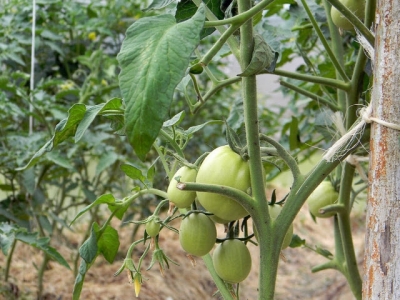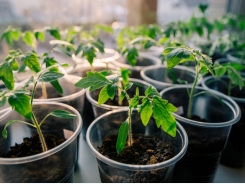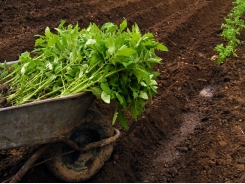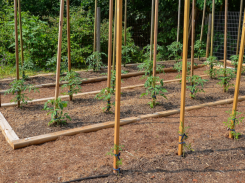How to Grow Your Own Tomatoes Part 4: Disease Prevention

Tomatoes are prone to a laundry list of diseases, including viral, bacterial and fungal assailants. Growers in the eastern half of the continent are almost sure to experience fungal diseases, such as early blight, late blight and septoria leaf spot, which proliferate in the humid environment.
To make matters worse, our beloved heirloom tomatoes, though they may be the tastiest, are usually the most disease-ridden. Yet every year, we plant again, and every summer, we have to do what we can to keep our plants healthy and productive.
The good news is that simple management practices are usually sufficient to hold back full-blown infections in tomato plants and keep them healthy enough to produce a good crop. If you want to explore the pathology of any particular symptoms that show up on your tomato plants, there are numerous guides to tomato diseases available online that are full of gory photos of deformed leaves and half-rotten fruits. Most of them cause similar-looking spots on the fruits or foliage at first, progressing to full on rot if the problem becomes severe.
Rather than get too bogged down in figuring out exactly which disease your tomatoes have, focus on keeping your plants healthy . The key is to start before there is ever any sign of disease.
Health and Hygiene
Hopefully, you’ve started the season off right by planting disease-resistant varieties. And hopefully, you’ve followed the instructions on the seed packet and planted seedlings with plenty of space between them (good airflow is key to preventing fungal disease). Training and trellising helps maintain airflow and keeps the fruit off the ground where the disease spores hide. If you remembered not to plant them in the same bed where they were riddled with blight last year, you’ll also be ahead of the game. Now, continue playing your cards right with a little tomato TLC so when a wet, rainy spell hits in mid-July, your crop will make it through.
Minimize Irrigation. Tomato plants have surprisingly low water needs and overwatering can promote disease. Once the fruit has started to form, water only when the top three inches of soil becomes dry and the leaves look limp in the heat of the day.
Water at Ground Level. Little can be done about water that falls from the sky, but don’t add insult to injury by showering your tomatoes with a sprinkler—fungal diseases only spread when the plants are wet. Instead, use drip irrigation or a soaker hose to water at ground level.
Water in the Morning. This way, the moisture will evaporate quickly from the surface of soil, giving the roots the water they need, but keeping the humidity down around the plants.
Mulch. Fungal spores overwinter in the soil and the main way they get onto the plants is when raindrops hit the ground and splash dirty water onto the foliage. From there, blight spreads up through the plant whenever conditions are sufficiently moist. Mulching helps by covering the fungal spores. Mulching also conserves moisture in the soil, so you don’t have to water as much. Straw or dried leaves are good choices for mulching tomatoes.
Remove Infected Leaves Immediately. Don’t hesitate to clip off leaves as soon as any spots or deformation is apparent—it may save the rest of the plant from succumbing to the disease. Dispose of these clippings far away from your tomato plants.
Prune Out Dense Foliage. Tomatoes tend to grow more thickly than is necessary, reducing air flow and producing more foliage than their immune systems can support. Prune out new sprouts that emerge from the main stems once fruit has begun to develop and train the plants to an open, spreading form.
Keep Adjacent Vegetation Down. A thicket of weeds or a tall patch of corn or beans next to your tomatoes blocks airflow and keeps the humidity high at ground level. Ideally, tomatoes should be planted out in the open with nothing but mulch, turf grass or other small stature crops (like basil or garlic) around them.
Disinfect Tomato Tools. Anything that you use to prune diseased tomato plants or to work the soil around them should be disinfected before using on or around healthy tomato plants (plants in the tomato family, which includes peppers, potatoes and eggplant). Dipping the tools in a 10 percent bleach solution or full-strength rubbing alcohol is effective.
Control Insect Pests. Tomatoes are rarely destroyed by insects, but they are frequently attacked on a small scale, which weakens the plants and makes them more susceptible to disease. Some insects are also responsible for spreading diseases. Small sucking insects (like scale, aphids and mites) can be dispatched with all-natural insecticidal soap. Larger bugs (like hornworms and stinkbugs) can be picked off by hand. Check the stems and both sides of the leaves if you see signs of insect damage.
Fertilize. Tomatoes are heavy feeders and will have greater disease resistance with a few boosts of fertilizer during the growing season. Once the fruit has set, apply a high phosphorus fertilizer every three weeks.
Tomato Rx
Most tomato diseases cannot be stopped once they are entrenched. There are fungicides and bactericides that can help, but they are only truly effective when applied as a preventative. There are products registered for use by organic farmers, such as copper sulfate, which are naturally derived but are still highly toxic. Organic farmers are only allowed to use those substances in extreme cases when they have documented that no other measures have been effective and they are in danger of significant economic losses if the disease were to progress.
Some home growers claim that piercing the base of the tomato plant with a strand of copper wire imbues them with antibiotic properties that keeps diseases at bay, though there is little scientific evidence to support this theory. Other home remedies range from hydrogen peroxide and baking soda sprays to applying a slurry of skim milk or just feeding the plants chamomile tea. While there may be merit to some of these approaches, waging war with tomato diseases is rarely a winning battle, making prevention the best cure.
Related news
Tools

Phối trộn thức ăn chăn nuôi

Pha dung dịch thủy canh

Định mức cho tôm ăn

Phối trộn phân bón NPK

Xác định tỷ lệ tôm sống

Chuyển đổi đơn vị phân bón

Xác định công suất sục khí

Chuyển đổi đơn vị tôm

Tính diện tích nhà kính

Tính thể tích ao




 How to Grow Your Own Tomatoes, Part 5:…
How to Grow Your Own Tomatoes, Part 5:…  How to Grow Your Own Tomatoes, Part 3:…
How to Grow Your Own Tomatoes, Part 3:…